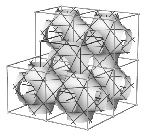|
The main properties of these 2-manifolds are (Figure
1): a. They are smooth, periodical and hyperbolic, and exist in the three-dimensional space. b. They divide the space into two identical subspaces, that graphically represent two interwoven and non-intersecting tunnel-networks. The two complementary tunnel systems are identical in volume and shape, and their tunnel axes form two identical, three-dimensional space networks. c. 2-fold rotation axes contained within the 2-manifold rotate one subspace into the identical complimentary subspace, forming in it a periodic (three-dimensional) space network, referred to as a “2-fold network”. An unequivocal distinction was made between minimal hyperbolic surfaces that can be physically realized by dipping a defined perimeter in soap solution (henceforth “soap membrane networks”) and minimal surfaces physically non-solvable through a dipping process. In the second stage of the research, a method for the enumeration and classification of the 2-manifolds that divide the space into two identical subspaces and identification of the axes of the identical dual tunnel networks was developed. The method of enumerating the 2-manifolds was based on their topological properties, that were studied in the previous stage. It is noteworthy that the issue of periodic minimal hyperbolic 2-manifolds that divide the space into two identical subspaces were investigated in the past with special regard to the first category of minimal surfaces realizable with a dipping process and related networks. Seven surfaces corresponding to these characteristics were found. The second category, that of periodic minimal surfaces which cannot be physically realized by dipping the perimeter in the soap solution, was investigated in connection with the division of the space into two identical subspaces in a very preliminary manner. It was clear even then that numerous identical networks and a smooth hyperbolic partition dividing them could be put through every E.P.R. containing 2-fold axes. No attempt has been made to date either to construct and characterize these surfaces or to define the range of their existence and to provide their classification. The existence and periodicity of the 2-manifolds that divide the space into two identical subspaces in the Euclidean three-dimensional space indicate the link between these 2-manifolds and the symmetry groups operating within this space. The “atomistic” conception of space suggests the existence of an E.P.R. that represent all the properties of the complex. Finding all the E.P.R.s, which represent identical-dual spaces and the 2-manifold in between them, leads to discovery of the 2-manifolds. The number of the different E.P.R.s is finite due to the fact that the number of symmetry groups, which operate in the Euclidean space is finite. The method for the enumeration and classification of the 2-manifolds consists of several consecutive steps described below; each step narrows down the scrutinized area and bring us closer to the final goal. a. Locating all the E.P.R.s derived from the symmetry groups. b. Reducing the list of the relevant E.P.R.s to those containing 2-fold axes, capable of rotating the E.P.R. into itself.
c.
Obtaining the 2-fold networks by repetitive duplication of the
E.P.R.s found in stage “b”.
d.
Locating periodic cells enclosed in the 2-fold networks (more than
one is likely), which may enclose a periodic unit of the 2-manifold, and
conducting exhaustive search to the possible 2-manifold units (Figure 2). e. Duplicating the periodic cells with the enclosed periodic unit of the 2-manyfolds, until a large enough section of the surface, enabling identification of the self-dual tunnel networks is obtained. f. Topological enumeration of each of the 2-manyfolds, according to their respective tunnel network.
|

